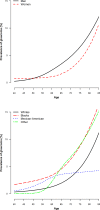Prevalence of Glaucoma in the United States: The 2005-2008 National Health and Nutrition Examination Survey
- PMID: 27168366
- PMCID: PMC4868098
- DOI: 10.1167/iovs.15-18469
Prevalence of Glaucoma in the United States: The 2005-2008 National Health and Nutrition Examination Survey
Erratum in
-
Erratum.Invest Ophthalmol Vis Sci. 2016 Jul 1;57(8):3891. doi: 10.1167/iovs.16-20050. Invest Ophthalmol Vis Sci. 2016. PMID: 27459666 Free PMC article. No abstract available.
Abstract
Purpose: To estimate the prevalence of glaucoma in the US population based on optic nerve head photography, to estimate the prevalence of glaucoma awareness, and to identify demographic and ocular risk factors for being unaware of having glaucoma.
Methods: The study included 5746 men and women 40 years of age and older participating in the National Health and Nutrition Examination Survey (NHANES) 2005-2008. Each participant had 45° photographs of the macula and optic disc of both eyes. Fundus photographs were first graded by a reading center, and those with a cup-to-disc ratio (CDR) ≥ 0.6 were regraded by three glaucoma specialists to determine the presence or absence of glaucoma. Analyses were performed using NHANES weights to account for the complex multistage probability sampling design.
Results: The estimated overall prevalence of glaucoma in the US civilian, noninstitutionalized population 40 years of age and older was 2.1% (95% confidence interval [CI], 1.7%-2.6%). Glaucoma affected 2.9 million individuals, including 1.4 million women; 1.5 million men; 2.3 million people 60 years of age and older; and 0.9 million blacks, Mexican Americans, and people of other races. The prevalence of glaucoma was highest in non-Hispanic blacks, followed by non-Hispanic whites, Mexican Americans, and others. Over half of participants with glaucoma were unaware that they had the disease.
Conclusions: The prevalence of glaucoma based on optic nerve fundus photography assessment in the general US population 40 years of age and older was 2.1%. Approximately half of glaucoma cases were previously undiagnosed. Studies to determine whether and how to identify undiagnosed glaucoma are an important next step.
Figures

References
-
- Tielsch JM,, Sommer A,, Katz J,, Royall RM,, Quigley HA,, Javitt J. Racial variations in the prevalence of primary open-angle glaucoma. The Baltimore Eye Survey. JAMA. 1991; 266: 369–374. - PubMed
-
- Klein BE,, Klein R,, Sponsel WE,, et al. Prevalence of glaucoma. The Beaver Dam Eye Study. Ophthalmology. 1992; 99: 1499–1504. - PubMed
-
- Quigley HA,, West SK,, Rodriguez J,, Munoz B,, Klein R,, Snyder R. The prevalence of glaucoma in a population-based study of Hispanic subjects: Proyecto VER. Arch Ophthalmol. 2001; 119: 1819–1826. - PubMed
-
- Varma R,, Ying-Lai M,, Francis BA,, et al. Prevalence of open-angle glaucoma and ocular hypertension in Latinos: the Los Angeles Latino Eye Study. Ophthalmology. 2004; 111: 1439–1448. - PubMed
MeSH terms
LinkOut - more resources
Full Text Sources
Other Literature Sources
Medical

